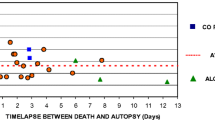Abstract.
Various methods are available for measuring the production of reactive oxygen species by phagocytes, but they are limited in their use by the need for their immediate application, cell isolation and of cell-activation by unphysiological stimuli. In addition, after measurement of reactive oxygen metabolites using oxidizing agents, the reduced compounds formed have to be determined during or immediately after their formation. In the present study, an improved cytochrome C assay was investigated which allowed measurements of superoxide anions in whole blood samples following activation of phagocytes by physiological stimuli such as the bacterial tripeptide N-formyl-methionyl-leucyl-phenylalanine (fMLP). The fMLP-stimulated production of superoxide anion (O2 –) showed a sigmoidal-shaped fMLP dose-response curve, and constant O2 – production rates (nmol·1–1×106 granulocytes) could be determined reliably up to a blood granulocyte concentration of 1×104·µl–1. To allow the determination of reduced cytochrome C later after its formation, the effect of long-term storage at –20°C on the stability of reduced cytochrome C was tested up to 16 weeks. The results obtained show that the determination of reduced cytochrome C in whole blood represents a simple and reliable method. Most importantly, O2 –-reduced cytochrome C can be frozen and stored without any alterations, at least up to 2 weeks. Thus the method seems to be superior to other methods of detection, especially when the experimental conditions do not allow immediate spectrophotometry (e.g. mountain medicine, space medicine). Under such conditions the present assay would allow reliable measurement of reduced cytochrome C, even after weeks of cryopreservation.
Similar content being viewed by others
Author information
Authors and Affiliations
Additional information
Electronic Publication
Rights and permissions
About this article
Cite this article
Choukèr, .A., Martignoni, .A., DaSilva, .L. et al. Cryopreservation of reduced cytochrome C for determination of N-formyl-methionyl-leucyl-phenylalanine-stimulated superoxide anion production in human whole blood. Eur J Appl Physiol 87, 365–372 (2002). https://doi.org/10.1007/s00421-002-0650-0
Accepted:
Issue Date:
DOI: https://doi.org/10.1007/s00421-002-0650-0




